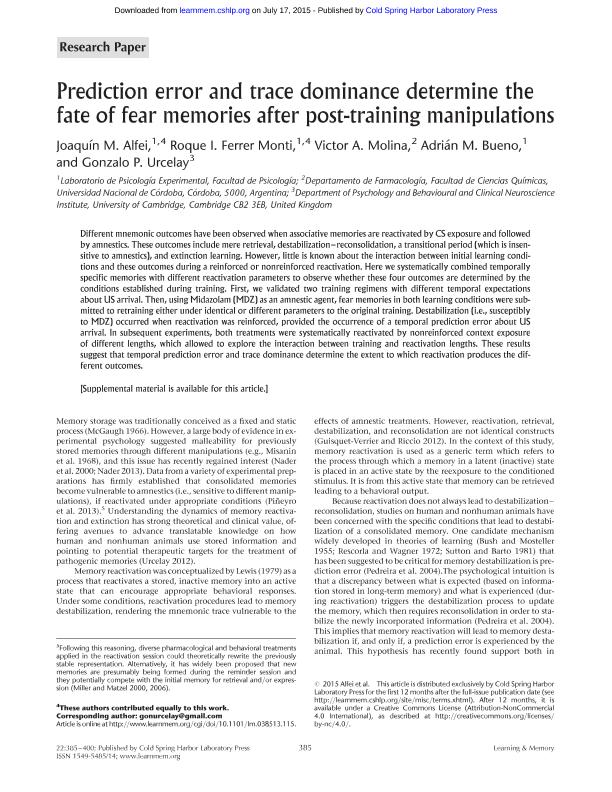Mostrar el registro sencillo del ítem
dc.contributor.author
Alfei Palloni, Joaquin Matías

dc.contributor.author
Ferrer Monti, Roque Ignacio

dc.contributor.author
Molina, Victor Alejandro

dc.contributor.author
Bueno, Adrián Marcelo

dc.contributor.author
Urcelay, Gonzalo Pablo

dc.date.available
2022-12-05T14:51:33Z
dc.date.issued
2015-08
dc.identifier.citation
Alfei Palloni, Joaquin Matías; Ferrer Monti, Roque Ignacio; Molina, Victor Alejandro; Bueno, Adrián Marcelo; Urcelay, Gonzalo Pablo; Prediction error and trace dominance determine the fate of fear memories after post-training manipulations; Cold Spring Harbor Laboratory Press; Learning & Memory (Cold Spring Harbor, N.Y.); 22; 8; 8-2015; 385-400
dc.identifier.issn
1072-0502
dc.identifier.uri
http://hdl.handle.net/11336/180178
dc.description.abstract
Different mnemonic outcomes have been observed when associative memories are reactivated by CS exposure and followed by amnestics. These outcomes include mere retrieval, destabilization- reconsolidation, a transitional period (which is insensitive to amnestics), and extinction learning. However, little is known about the interaction between initial learning conditions and these outcomes during a reinforced or nonreinforced reactivation. Here we systematically combined temporally specific memories with different reactivation parameters to observe whether these four outcomes are determined by the conditions established during training. First, we validated two training regimens with different temporal expectations about US arrival. Then, using Midazolam (MDZ) as an amnestic agent, fear memories in both learning conditions were submitted to retraining either under identical or different parameters to the original training. Destabilization (i.e., susceptibly to MDZ) occurred when reactivation was reinforced, provided the occurrence of a temporal prediction error about US arrival. In subsequent experiments, both treatments were systematically reactivated by nonreinforced context exposure of different lengths, which allowed to explore the interaction between training and reactivation lengths. These results suggest that temporal prediction error and trace dominance determine the extent to which reactivation produces the different outcomes.
dc.format
application/pdf
dc.language.iso
eng
dc.publisher
Cold Spring Harbor Laboratory Press

dc.rights
info:eu-repo/semantics/openAccess
dc.rights.uri
https://creativecommons.org/licenses/by-nc/2.5/ar/
dc.subject
REACTIVATION
dc.subject
RECONSOLIDATION
dc.subject
MEMORY
dc.subject
FEAR
dc.subject.classification
Neurociencias

dc.subject.classification
Medicina Básica

dc.subject.classification
CIENCIAS MÉDICAS Y DE LA SALUD

dc.subject.classification
Otras Psicología

dc.subject.classification
Psicología

dc.subject.classification
CIENCIAS SOCIALES

dc.title
Prediction error and trace dominance determine the fate of fear memories after post-training manipulations
dc.type
info:eu-repo/semantics/article
dc.type
info:ar-repo/semantics/artículo
dc.type
info:eu-repo/semantics/publishedVersion
dc.date.updated
2022-12-05T10:49:11Z
dc.journal.volume
22
dc.journal.number
8
dc.journal.pagination
385-400
dc.journal.pais
Estados Unidos

dc.journal.ciudad
Nueva York
dc.description.fil
Fil: Alfei Palloni, Joaquin Matías. Universidad Nacional de Córdoba; Argentina. Consejo Nacional de Investigaciones Científicas y Técnicas; Argentina
dc.description.fil
Fil: Ferrer Monti, Roque Ignacio. Universidad Nacional de Córdoba; Argentina. Consejo Nacional de Investigaciones Científicas y Técnicas; Argentina
dc.description.fil
Fil: Molina, Victor Alejandro. Universidad Nacional de Córdoba; Argentina. Consejo Nacional de Investigaciones Científicas y Técnicas; Argentina
dc.description.fil
Fil: Bueno, Adrián Marcelo. Universidad Nacional de Córdoba; Argentina. Consejo Nacional de Investigaciones Científicas y Técnicas; Argentina
dc.description.fil
Fil: Urcelay, Gonzalo Pablo. University of Cambridge; Reino Unido
dc.journal.title
Learning & Memory (Cold Spring Harbor, N.Y.)

dc.relation.alternativeid
info:eu-repo/semantics/altIdentifier/url/http://learnmem.cshlp.org/content/22/8/385
dc.relation.alternativeid
info:eu-repo/semantics/altIdentifier/doi/http://dx.doi.org/10.1101/lm.038513.115
Archivos asociados
